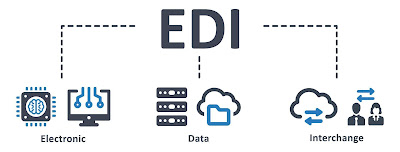What is EDI (Electronic Data Interchange) ?
Electronic Data Interchange (EDI)
Electronic Data Interchange (EDI) is the computer-to-computer exchange of business documents in a standard electronic format between business partners (B2B Model). EDI replaced the traditional paper-based business process. The main idea of Electronic Data Interchange is to allow a business application to take place without human intervention.EDI helps many organizations that produce, ship, purchase and sell goods and provide care, from retailers and manufacturers to logistics firms, airlines, healthcare providers, insurers, and more.
Although EDI has been in use since the 1960s, EDI is finding new use in today's world, enabling supply chain automation, digital transformation, and even as a key part of the workflow and business process automation. In this article, we will highlight and introduce you to all the basics of EDI, which include:
- What is EDI?
- How does EDI work?
- Benefits of EDI
- Applications of EDI
- EDI for e-commerce
What is EDI?
Electronic Data Interchange (EDI) is the computer-to-computer exchange of business documents in a standard electronic format between business partners (B2B Model).
How does EDI works?
Electronic Data Interchange works based on standards that determine how each message should be formatted. There are mainly four EDI standards:
- UN/EDIFACT- Internationally recognized, mostly used outside of North America
- ANSI ASC X12- used within North America
- TRADCOM- used by British retail
- ODETTE- used by European automakers
Benefits of EDI
The Benefits of Electronic Data Interchange (EDI) are as follows:
- Reduction in data entry errors
Using EDI helps in fewer chances of errors while using the computer for data entries.
- Shorter processing lifecycle
One of the benefits of EDI is orders can be processed as soon as they are entered int the system. It also reduces the processing time to transfer the documents.
- Electronic form of data
EDI makes it quite easy to transfer and share data because data is in electronic format.
- Reduction in paperwork
Electronic Data Interchange helps in a huge reduction in paperwork as a lot of paper files, and documents are replaced with electronic documents.
- Cost Effective
EDI proves to be highly cost-effective. It saves a lot of time and orders are processed very effectively.
- Standard means of communication
Electronic Data Interchange (EDI) helps in clearer communication. EDI enforces standards on the content of data and its format
Applications of Electronic Data Interchange
The Applications of Electronic Data Interchange (EDI) are as follows:
- Retail Sector
EDI helps the retail sector in efficient inventory management by providing a structured way to maintain and replenish goods stocked in the retail sector. Retailers use a common model stock for each shop location and the point of sale stock position is updated continuously and data in fed via EDI enable SCM network. EDI software monitors all the logistics and makes updates in original stocks.
- Manufacturing sector
In the manufacturing sector, EDI facilitates material requirement planning and just in time manufacturing. The inventory position of original equipment manufacturer (OEM) is constantly updated through EDI and the supplier is notified about shortage of materials. This helps the suppliers to plan and schedule supply according to the requirements of manufacturer.
- Automobile Sector
In automobile sector, EDI is used to keep customers updated with current product and pricing information during the purchase cycle. The customers can also make payment on receipt of goods via EDI to speed the payment process
- Financial Sector
The application of EDI in the Financial sector is that it replaces the labor-intensive activities of collecting, processing, and dispersing payments with an electronic system. A payee's bank account is electronically credited and the payer's account is electronically debited on scheduled day of payment which is also known as electronic fund transfer.
EDI for e-commerce
EDI is an electronic way of transferring business documents in an organization internally, between its various departments, or externally with suppliers, customers, or any subsidiaries. In Electronic Data Interchange paper documents are replaced by electronic documents like Word documents, excel, spreadsheets, etc.
EDI Documents
Some important documents used in EDI are as follows:
- Invoices
- Purchase orders
- Shipping Requests
- Acknowledgment
- Business Correspondence letters
- Financial information letters
Frequently Asked Questions
What does EDI stand for?
EDI stands for Electronic Data Interchange. It is the computer-to-computer exchange of business documents in a standard electronic format between business partners (B2B Model).
Also read
References
https://arc.cdata.com/resources/edi
https://www.edibasics.com/what-is-edi
https://www.tutorialspoint.com/e_commerce/e_commerce_edi.htm
http://www.dspmuranchi.ac.in/pdf/Blog/Electronic%20Data%20Interchange%20EDI.pdf
https://www.b2be.com/blog/frequently-asked-questions-about-edi-part-2
https://bbamantra.com/electronic-data-interchange-edi

